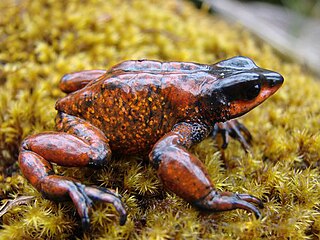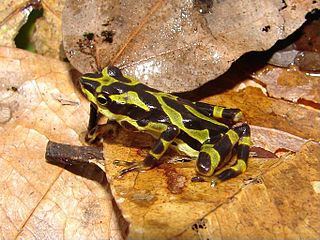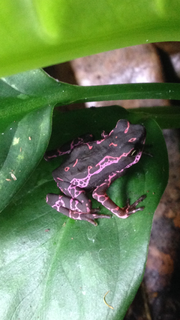
Atelopus is a large genus of true toads, commonly known as harlequin toads or stubfoot toads, from Central and South America, ranging as far north as Costa Rica and as far south as Bolivia. Atelopus species are small, generally brightly colored, and diurnal. Most species are associated with mid-to-high elevation streams. This genus has been greatly affected by amphibian declines, and many species are now considered endangered, while others already are extinct. Almost 40% of the described species in the genus are considered possibly extinct; this is raised to 45% when data deficient species are added; this number may be even higher, given that the genus contains many undescribed species that could also be extinct, and many of the species considered critically endangered but extant may have gone extinct after the last surveys that detected them, or could go extinct in the future. While threatened by habitat loss, pollution, and introduced species, the primary cause of these declines appears to be the chytrid fungus Batrachochytrium dendrobatidis. For example, there are 32 known Atelopus species in Ecuador. One of these is data deficient, two are endangered and the remaining are critically endangered. Almost half the Ecuador species have not been recorded in a decade or more and are likely extinct. In some species conservationists have established captive colonies as a safeguard. However, numerous Atelopus species have been rediscovered decades after their last sighting, such as A. arsyescue, A. mindoensis, A. bomolochos, A. ignescens, A. balios, A. longirostris, A. subornatus and A. varius.

Atelopus longirostris is a species of harlequin frog, a member of the family of true toads (Bufonidae). It has been recorded only in northern Ecuador. Records from Colombia probably represent different species. As of mid-2017, it is listed as extinct by the IUCN, but was rediscovered in 2016 after more than two decade with no sightings. The scientific name of this species means "long-snout" and the species has been named in Spanish as the jambato hocicudo. Common names longnose stubfoot toad, scrawny stubfoot-toad, and longnose sharlequin frog have been coined for it.

Atelopus balios, the Rio Pescado stubfoot toad, is a species of toad in the family Bufonidae. It is endemic to southwestern Ecuador, with records from Pacific lowlands in Azuay, Cañar, and Guayas Provinces. It is a rare species that was already suspected to be extinct, but a single specimen was discovered in 2011 by a team from Conservation International during a hunt for missing amphibians. The decline in amphibian populations is well documented. The Atelopus balios is Critically Endangered as a result of the widespread amphibian Chytridiomycosis fungus that has decimated other amphibian populations. There are only 10 known findings of the tadpole, Atelopus balios.
Atelopus bomolochos, the Azuay stubfoot toad or Cuenca jambato frog, is a species of toad in the family Bufonidae. It is endemic to southern Ecuador and known from Cordillera Oriental in the Azuay, Cañar, and Loja Provinces.

The Guajira stubfoot toad or Carrikeri harlequin frog, Atelopus carrikeri, is a species of toad in the family Bufonidae. It is about 5 cm (2.0 in) long and typically black, though some populations have orange coloration. This species is endemic to the Sierra Nevada de Santa Marta mountain range of northern Colombia. It is critically endangered because of the chytrid fungus, Batrachochytrium dendrobatidis, and habitat destruction due to agriculture. The species had not been seen from 1994 until it was rediscovered in early 2008.

Atelopus chiriquiensis, the Chiriqui harlequin frog or Lewis' stubfoot toad, is an extinct species of toad in the family Bufonidae that was found in the Cordillera de Talamanca in Costa Rica and western Panama. Its natural habitats were stream margins in lower montane wet forests and rainforests. Its elevational range was 1,400–2,500 m (4,600–8,200 ft) asl.

Atelopus cruciger, also known as the Veragua stubfoot toad or Rancho Grande harlequin frog, is a species of toad in the family Bufonidae. It is endemic to Venezuela and is known from the central Venezuelan Coastal Range. The species was already suspected to be extinct because, despite considerable effort, none had been found since 1986. However, in 2003, a small population was found, with few other locations discovered later. It is mainly threatened by chytridiomycosis. It is locally called sapito rayado.

The elegant stubfoot toad or Pacific jambato frog is a species of toad in the family Bufonidae found in lowlands and Andean slopes of northwest Ecuador to 1,140 m (3,740 ft) asl and on the Gorgona Island, off southwest coast of Colombia. It was described by George Albert Boulenger in 1882 based on a specimen collected by Edward Whymper. It is known in Spanish as rana jambato del Pacífico or simply jambato del Pacífico.

Atelopus ignescens, the Jambato toad or Quito stubfoot toad, is a species of toad in the family Bufonidae. It is endemic to the northern Andes of Ecuador. This once abundant species was believed to be extinct until its rediscovery in 2016. The specific name ignescens means "to catch fire", presumably in reference to the orange ventral color of this species.
Atelopus longibrachius, the El Tambo stubfoot toad, is a species of toad in the family Bufonidae. It is endemic to Colombia and known from the region of its type locality, El Tambo, Cauca, as well as from Chocó, both on the western flanks of Cordillera Occidental. Its natural habitats are tropical moist lowland forests where it lives on the ground. Breeding is assumed to take place in streams. It is potentially threatened by chytridiomycosis and habitat loss.
Atelopus senex is an extinct species of toad in the family Bufonidae. It was endemic to Costa Rica and known from the Cordillera Central and Cordillera de Talamanca at elevations of 1,100–2,200 m (3,600–7,200 ft) asl.

Atelopus spurrelli is a species of toad in the family Bufonidae. It is endemic to Colombia and occurs in the Pacific lowlands and foothills of the Cordillera Occidental. The specific name spurrelli honors Herbert George Flaxman Spurrell, a British physician and zoologist. Common name Condoto stubfoot toad has been coined for this species.
Atelopus subornatus is a species of toad in the family Bufonidae. It is endemic to Colombia and is restricted to the Cordillera Oriental in the Cundinamarca Department. Common name Bogota stubfoot toad has been coined for this species.

Atelopus petersi is a species of toads in the family Bufonidae. It is endemic to Ecuador and is known from the Cordillera Oriental in the Napo Province and more provisionally, in the Chimborazo Province. The specific name petersi honors James A. Peters, an American zoologist who collected the first specimens of this species in 1962 and provided a description under the name Atelopus pachydermus. Common names Peters' stubfoot toad and Peters' jambato toad have been coined for it.

Atelopus barbotini, popularly known as the purple fluorescent frog or more accurately the purple harlequin toad, is a species of toad in the family Bufonidae. It is endemic to the uplands of central French Guiana.

The Chocó–Darién moist forests (NT0115) is an ecoregion in the west of Colombia and east of Panama. The region has extremely high rainfall, and the forests hold great biodiversity. The northern and southern parts of the ecoregion have been considerably modified for ranching and farming, and there are threats from logging for paper pulp, uncontrolled gold mining, coca growing and industrialisation, but the central part of the ecoregion is relatively intact.

The Northwestern Andean montane forests (NT0145) is an ecoregion on the Andes mountains in the west of Colombia and Ecuador. Both flora and fauna are highly diverse due to effect of ice ages when the warmer climate zones were separated and the cooler ones combined, and interglacial periods when the reverse occurred. Because the environment is hospitable to humans, the habitat has been drastically modified by farming and grazing since the Pre-Columbian era.

The Eastern Cordillera Real montane forests (NT0121) is an ecoregion in the eastern range of the Andes of southern Colombia, Ecuador and northern Peru. The ecoregion covers the eastern slopes of the Andes, and includes montane forest that rises from the Amazonian rain forest, with cloud forest and elfin forest at higher elevations. It is rich in species, including many endemics. It is threatened by logging and conversion for pasturage and subsistence agriculture.















